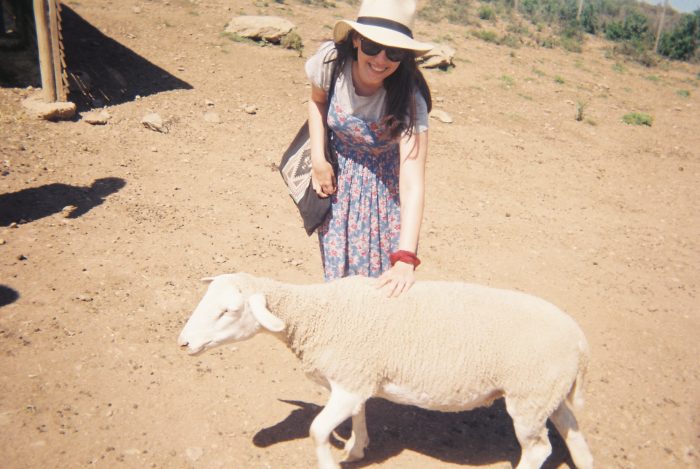“Imagine a beach,” says a strategically low, soothing voice.
And already I am lost.
What sort of beach? What climate? Wait, now there are trees? Okay, so we’re talking tropical; I can work with that. Breathe. Ugh, I can hear the neighbour’s washing machine on spin cycle. Okay, focus on the breath. Wait we’re up a hill now?
My first foray into “visualisation” and guided meditation did not go well. Like many people, I think, I couldn’t be present. Unlike many neurotypical people, though, my potential distractions included the sounds of LED lights and people walking downstairs.
I am an autistic adult who was diagnosed late in life, like many AFAB (assigned female at birth) people on the spectrum. I am also invested in meditation as a secular practice. So how and why do I merge these two aspects of my life?
Many autistic people also struggle with visualisation. Either, we have overly visual minds, and so the guided descriptions interrupt and contradict the rich picture that we developed once the speaker starts, or we cannot conjure pictures at all, thanks to aphantasia.
The sounds of the guide’s voice and breathing may be sensory triggers, and problems with interoception (the ability to feel what is happening within our own bodies) may make some of the core elements of the practice tricky. Sensory sensitivities may make relaxing into a quiet space feel nearly impossible. But that’s exactly what makes meditation, and more specifically, mindfulness practice, so useful.
Neurotypical people find the world overwhelming. Imagine how it is for us. The sounds are louder, the smells stronger, our relationship to our bodies more treacherous, and to top it all off, our self-soothing behaviours (stims) often are repressed.
Mindfulness as a skill can help with sensory overload and meltdowns. Now, let me make this very clear, there is no cure for meltdowns. There is no cure for autism. And there needn’t be. What we need is a world that accommodates difference, not one that seeks to force us all to process and behave identically. That being said, we don’t live in that world, and as autistic individuals, we need coping skills to navigate a world that was not designed to hold us.
Beyond the help that mindful practices provide with sensory overload, they can help us in our interpersonal lives by assisting with emotional regulation. Myths about autistic people lacking empathy are pervasive, but many autistic individuals, if you bother to ask us, tell a different story.
We often feel the emotions of the room and notice subtle changes in the way people we know are responding. We know you’re upset. We just don’t have the understanding of why or what to do about it. So we may misattribute, or worse, blame ourselves. That’s without even going into the fact that many people on the spectrum are more likely to be abuse survivors making us hypervigilant. That sounds pretty exhausting, right? Well, it is.
Add to this, the fact that we may project our thoughts. Because of the problems we have with “theory of mind,” we may assume that if we are upset, you are upset. We may “mindread” as cognitive behavioral therapy (CBT) would put it, which leads to conflict and misunderstandings. Regular mindful practise can help us identify our own feelings and thoughts, rather than pushing them onto those around us.
On that note, many of us struggle with alexithymia, or the inability to recognise emotions within ourselves. I particularly struggle to recognise that I am anxious and will often “feel” fine until physical symptoms emerge. It’s fairly obvious how spending time checking in with ourselves and our bodies can help to recognise, if not the emotion itself, the physical manifestations that are more subtle, so that we can identify and work with the underlying emotional state.
So now that we understand the benefits that regular mindfulness practice can have for us as autistic individuals, how do we go about overcoming some of the hurdles?
I am no expert, but these are a few things that have helped me.
1. F*ck being still.
I have realised that my stims help me meditate. I have spasms in my back and frisson when I get into a heavy meditative flow. Many people report involuntary movements while meditating. Perfect stillness is not the aim; the calmness of the mind and the ability to focus and observe is.
For autistic people, that means letting us stim in non-distracting ways. I’d even argue some stims are inherently meditative. When I use visual stims like light prisms and crystals, there’s a state of mind that comes over me that feels similar to meditation when it goes well.
This can be a great way to introduce children to small mindful practices. Try a sensory lamp or a DIY glitter jar.
2. Make your guides clear if you are a creator.
Please. I know you want to go at a relaxing pace, but keep them simple and clear.
Try different methods. I can’t do guided visualisations. I can visualise well, but the guides go at a different pace to my brain and I spend more time correcting the mental picture I am making, than actually getting into the flow.
Guided practices that talk more about breath and the body, on the other hand, work great for me and non-guided practice does too, whether with some music in my headphones to help block out sound on bad sensory days, or, when able, with no music, just with the practice (but that takes time and is not always possible).
3. Start small.
Start with a set of mindful walks or three-minute breathing exercises. Meditation, especially, can be overwhelming, but the ability to notice the world around you without having it and your thoughts overwhelm you is worth the effort.
Recognise that some days will be easier than others. Some days are bad sensory days or low energy days, and that means it will be harder to everything, including meditating or taking a walk without getting overloaded. There’s nothing wrong with going back to a more simple practice, no matter how far along in your journey you are. I have days where I can meditate and go into a trance from breathing, and I have days where I can only manage to focus on counting my breath. That’s normal.
I hope that this perspective has helped you.
A lot of these ideas apply to people who are not autistic or are neurodivergent in other ways. The point is we are all different; our needs are all different. So our practices should all be different.
Try to abandon the image of what you think meditation and mindfulness should look like. Whether that’s the stoic philosopher in his cave or the lady down the road who always seems to have a green juice in her hand. We don’t need to put pressure on ourselves to perform or mask in yet another aspect of our lives.
Let yourself be and take time to help yourself in the ways that work for you.
~









Read 0 comments and reply